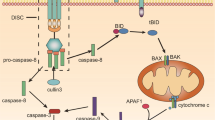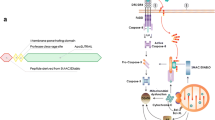Abstract
Tumor necrosis factor (TNF)-related apoptosis-inducing ligand (Apo2L/TRAIL) is a new member of the TNF superfamily. In this work, the key role of Zn2+ in high-level expression of soluble TRAIL was confirmed. The yield of soluble TRAIL reached 1.6 g l−1 using a novel, two-stage Zn2+ feeding strategy, and the accumulation of TRAIL inclusion bodies decreased. Furthermore, the purified TRAIL showed stronger cytotoxicity activity against human pancreatic 1990 tumor cells as the molar ratio of Zn2+ to TRAIL monomer was 2 in purified TRAIL solution.
Similar content being viewed by others
References
Aggarwal BB, Kohr WJ, Hass PE, Moffat B, Spencer SA, Henzel WJ, Bringman TS, Nedwin GE, Goeddel DV, Harkins RN (1985) Human tumor necrosis factor. J Biol Chem 260:2345–2354
Bodmer JL, Meier P, Tschopp J, Schneider P (2000) Cysteine 230 is essential for the structure and activity of the cytotoxic ligand TRAIL. J Biol Chem 275:20632–20637
Cha SS, Kim MS, Choi YH, Sung BJ, Shin NG, Shin HC, Sung YC (1999) 2.8 Å resolution crystal structure of human TRAIL, a cytokine with selective antitumor activity. Immunity 11:253–261
Hymowitz SG, Christinger HW, Fuh G, Ultsch M, Oȁ9Connel M, Kelley RF, Ashkenazi A, de Vos AM (1999) Triggering cell death: the crystal structure of Apo2L/TRAIL in a complex with death receptor5. Mol Cell 4:563–571
Hymowitz SG, Oȁ9Connell MP, Ultsch MH, Hurst A, Totpal K, Ashkenazi A, de Vos AM, Kelley RF (2000) A unique zinc-binding site revealed by a high-resolution X-ray structure of homotrimeric Apo2L/TRAIL. Biochemistry 39:633–640
Kemp TJ, Kim JS, Crist SA, Griffith TS (2003) Induction of necrotic tumor cell death by TRAIL/Apo-2L. Apoptosis 8:587–599
Lee SY (1996) High cell-density culture of Escherichia coli. Trends Biotechnol 14:98–105
Luo QP, Shen YL, Wei DZ, Cao W (2005) Optimization of culture on the overproduction of TRAIL in high-cell-density culture by recombinant Escherichia coli. Appl Microbiol Biotechnol. DOI 10.1007/s00253-005-0131-6
Pitti RM, Marsters SA, Ruppert S, Donahue CJ, Moore A, Ashkenazi A (1996) Induction of apoptosis by Apo-2 ligand, a new member of the tumor necrosis factor cytokine family. J Biol Chem 271:12687–12690
Seeger A, Schneppe B, McCarthy JEC, Deckwer WD, Rinas U (1995) Comparison of temperature and isopropyl-β-d-thiogalacto-pyranoside-induced synthesis of basic fibroblast growth factor in high-cell-density cultures of recombinant Escherichia coli. Enzyme Microbial Technol 17:947–953
Shen YL, Xia XX, Zhang Y, Liu JW, Wei DZ, Yang SL (2003) Refolding and purification of Apo2L/TRAIL produced as inclusion bodies in high-cell-density cultures of recombinant Escherichia coli. Biotechnol Lett 25:2097–2101
Shen YL, Zhang Y, Sun AY, Xia XX, Wei DZ, Yang SL (2004) High-level production of soluble tumor necrosis factor-related apoptosis-inducing ligand (Apo2L/TRAIL) in high-density cultivation of recombinant Escherichia coli using a combined feeding strategy. Biotechnol Lett 26:981–984
Walczak H, Miller RE, Arial K, Gliniak B, Griffith TS, Kubin M, Chin W, Jones J, Woodward A, Le T, Smith C, Smolak P, Goodwin RG, Rauch CT, Schuh JCL, Lynch DH (1999) Tumoricidal activity of tumor necrosis factor-related apoptosis-inducing ligand in vivo. Nature Medicine 5:157–163
Wang LH, Zhu YP, Lou YH, Zhou JS, Peng YZ, Qiu Y, Jiao BH (2002) High density fermentation in preparation of recombinant soluble human TRAIL. Acad J Sec Mil Med Univ 23:132–135
Wiley SR, Schooley K, Smolak PJ, Din WS, Huang CP, Nicholl JK, Sutherland GR, Smith TD, Rauch C, Smith CA (1995) Identification and characterization of a new member of the TNF family that induces apoptosis. Immunity 3:673–682
Yin L, Jian C, Ying YM, Shi YL, Yoon MK (1998) Effect of additives and fed-batch culture strategies on the production of glutathione by recombinant Escherichia coli. Proc Biochem 33:709–714
Acknowledgement
This work was supported by a grant from the Ministry of Science and Technology (Key Project of the National High Technology Research and Development Program of China (863 Program): No. 2002AA2Z345A)
Author information
Authors and Affiliations
Corresponding author
Rights and permissions
About this article
Cite this article
Sun, AY., Shen, YL., Yin, JC. et al. Improvement of Expression Level and Bioactivity of Soluble Tumor Necrosis Factor-Related Apoptosis-Inducing Ligand (Apo2L/TRAIL) by a Novel Zinc ion Feeding Strategy. Biotechnol Lett 28, 1215–1219 (2006). https://doi.org/10.1007/s10529-006-9073-z
Received:
Accepted:
Published:
Issue Date:
DOI: https://doi.org/10.1007/s10529-006-9073-z




